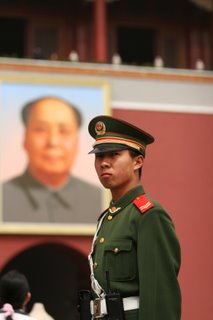
10NOV06 Monks, Momos and Monasteries.

Monks, momos (meat or vegetable filled dumplings) and monasteries are just some of the things that characterize Tibet, along with the daily hundreds of pilgrims at the Jokhang Temple and Potala Palace in Lhasa.

The Jokhang is the first and most sacred temple in Tibet, the heart of the old Lhasa. Originally founded in the 7th century by the first Tibetan king, Songtsen Gampo, and has been built in many stages, with major extensions and remakes in the 17th-18th centuries.
Because the temple is not controlled by a particular sect of Tibetan Buddhism it attracts adherents of all the sects as well as followers of Bon-Po, Tibet's indigenous religion. Three pilgrimage circuits exist in Lhasa, each directing pilgrims to the Jowo Sakyamuni statue: the Lingkhor, which encircles the city’s sacred district; the Barkhor, which encloses the Jokhang temple; and the Nangkhor, a ritual corridor inside the Jokhang. Every day throughout the year hundreds of pilgrims circumambulate each of these three circuits. Some pilgrims will cover the entire distance by prostrating every few feet, and others will walk slowly, chanting sacred mantras and spinning hand-held prayer wheels. For more than a thousand years, millions of pilgrims have trod these sacred paths with incredible devotion and piety. The flagstones close to the main entrance of the Johkang attest to this history, their surfaces polished by the countinuous rubbing of pilgrims that prostrate stretching their body on the ground. Around the Jokhang you can meet pilgrims coming from all the regions of Tibet, wearing their characteristic regional dress and ornaments. Other than the pilgrims that populate the Barkhor area surrounding the Jokhang Temple, are the vendors selling souvenirs from prayer wheels and colorful prayer flags to t-shirts, incense and jewelry. Tourists sometimes join in the prayer and pilgrimage around the temple and other holy sites as well. I took the opportunity to do as the pilgrims and circled the Jokhang and the Potala palaces. It was quite an amazing feeling being part of the swirling mass of people. I definitely felt like I was really experiencing Tibet by taking part in this centuries old tradition.
Other than the pilgrims that populate the Barkhor area surrounding the Jokhang Temple, are the vendors selling souvenirs from prayer wheels and colorful prayer flags to t-shirts, incense and jewelry. Tourists sometimes join in the prayer and pilgrimage around the temple and other holy sites as well. I took the opportunity to do as the pilgrims and circled the Jokhang and the Potala palaces. It was quite an amazing feeling being part of the swirling mass of people. I definitely felt like I was really experiencing Tibet by taking part in this centuries old tradition.






























